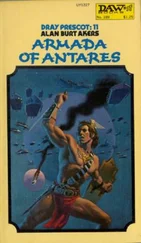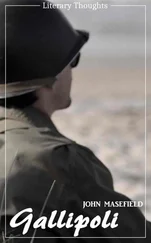On Tenedos an airfield 800 yards long had been constructed with the aid of Greek workmen who uprooted a vineyard and with oil drums filled with cement rolled the ground moderately flat. But it was not altogether a satisfactory base. From the island the Gallipoli peninsula could be clearly seen, but Cape Helles was seventeen and a half miles away, and Gaba Tepe, where the Australians and New Zealanders were to land, thirty-one miles, and these were formidable distances for an aircraft in those days. Constantinople, of course was out of the question.
Despite these hazards Samson, doing a great deal of flying himself, was already beginning to produce useful results. Carrying volunteer naval officers as observers — usually light-weight midshipmen — he got his new radio-telephone into use, and the spotting for the Fleet’s guns greatly improved. Since the radiotelephone was a one-way system the warships checked back the messages they received with a searchlight. Several bombardments had been carried out in this way, notably the raid on Maidos on April 23.
Much the most important part of Samson’s work, however, in these last days before the attack was his photography of the enemy entrenchments. Hamilton and Keyes together made a close study of these photographs, and were not reassured. At all but one or two places where the landings were to be made there were abundant signs of barbed-wire. This wire was becoming a nightmare in all their minds, and Hamilton privately confided to Samson that he feared that the casualties might be as high as fifty per cent in the first landing. Had they been able to get hold of some of the Navy’s new armoured invasion boats it might have been a different story — but these were a closely guarded secret in the Admiralty at the time, and not even Kitchener was supposed to know anything about them.
When Hamilton had left the Dardanelles in March it had been understood that the Navy would keep harassing the Turks with a series of bombardments along the coast; but now it was found that all such operations were impossible. The entire energies of the Fleet were consumed in the arrangements for the landing. It was decided that the bulk of the invasion force should assemble in Mudros Harbour in the island of Lemnos, with subsidiary bases on Imbros, Tenedos and Skyros. Forty-eight hours before the landing the Fleet with the Army on board would start to move towards its battle stations off the Gallipoli peninsula. A mile or two from the coast the soldiers would be transferred to lighters and small boats and these, in groups of four, would be towed by launches to the shore. The actual landing would take place in the first light of dawn, the assaulting troops carrying with them nothing more than 200 rounds of ammunition, their rifles and trenching tools and three days’ rations.
All this required elaborate preparation: the construction of tows and wharves and barges; the training of midshipmen in piloting launches to fixed points on the strange coast in darkness; the study of the currents and the weather; the arrangements for getting animals on shore and the piping of fresh water from the ships to the beaches; the fixing of signals and codes; the allotting of targets to the battleships and cruisers which would support the landing; the working-out of the whole vast time-table for the movements of the Fleet. Every problem was new or at any rate unusual; there was even a plan for evacuating the Army in case the assault miscarried either in part or altogether.
Meanwhile Hamilton’s 75,000 men had to be transported from Egypt to the islands, a distance of some 700 miles.
Astonishingly — even miraculously — these arrangements and many others went forward without any major setback. Just once the crew of a transport on its way to Lemnos was forced to abandon ship when a Turkish destroyer appeared, but the enemy torpedoes went clean under the vessel’s keel and soon the men were scrambling back on board. Chased by British destroyers the Turkish ship ran for the shore, and beached herself off Chios. Even the weather seemed to prove that Hamilton had been wise to delay, for there were hardly two fine days together in the first fortnight in April. Provisionally the day for the assault was fixed on April 23, which was St. George’s Day; the moon then was due to set two hours before dawn, and thus the armada would be able to approach the coast in the darkness. But on April 21 half a gale set in, and the attack was postponed, at first twenty-four and then forty-eight hours. Finally Sunday, April 25, was chosen as the day.
The island of Lemnos, which had been loaned to the Allies by the Venizelist government in Greece, is reputed to be the abode of Vulcan, and the Argonauts are said to have rested there for a time. By the standards of the Ægean Sea it is not, however, a beautiful place. Few trees can be made to grow, and the local inhabitants have never been able to scratch much more than a bare living from the harsh volcanic rock and the surrounding sea. An uneventful timeless life goes by.
This island now became, in April 1915, the scene of one of the great maritime spectacles of the war. Ship after ship steamed into Mudros Harbour until there were some two hundred of them anchored there, and they made a city on the water. In addition to the warships, every possible variety of vessel had been pressed into service to transport the troops: brightly-painted Greek caiques and pleasure steamers, trawlers and ferryboats, colliers and transatlantic liners. Among the long lines of great battleships and cruisers some vessels, like the Russian cruiser Askold , became great objects of wonder. The Askold carried five extremely tall perpendicular funnels, and the soldiers at once renamed her the Packet of Woodbines. Then there was the ancient French battleship Henri IV , which had scarcely a foot of freeboard and a superstructure so towered and turreted that she looked like a medieval castle, a Braque drawing in heavy grey. These antiquities found themselves lying side by side with the latest submarines and destroyers.
A detached observer might have found the scene almost gay and regatta-like. From shore to ship and from ship to ship swarms of motor-boats and cutters ran about. Every vessel flew its flag, the smoke from hundreds of funnels rose up into the sky, and from one direction or another the sound of bugles and military bands was constantly floating across the water. There was movement everywhere. On the crowded ships the men who were to make the first assault were exercised in getting down rope ladders into boats. Others drilled on deck. Others again exercised the animals on shore. By night thousands of lights and signal lamps sparkled across the bay.
In the midst of this scene, dominating it and imparting an air of great strength and resolution, rode the flagship, the Queen Elizabeth , in which Hamilton had decided to make his headquarters with de Robeck until he was able to set up on shore on the Gallipoli peninsula.
An immense enthusiasm pulsated through the Fleet. With the sight of so many ships around them it seemed to all but a few sceptics more certain than ever that they could not fail. Everyone was delighted when the men scrawled slogans across the sides of their transports: ‘Turkish Delight’; ‘To Constantinople and the Harems’. They lined the decks shouting and cat-calling to one another, cheering each ship that arrived or departed from the harbour. Finally the excitement of the adventure had seized upon everybody’s mind, and the inward choking feeling of dread was overlaid by an outward gaiety, by the exaltation and otherworldness that chloroforms the soldier in the last moments of waiting.
The morning of April 23 broke fine and dear, and de Robeck gave orders for the operations to begin. All that day and on the day following the slower transports amid cheers moved out of Mudros and steamed towards their rendezvous off the beaches. By the evening of Saturday, April 24, the 200 ships were in motion, those carrying the Royal Naval Division headed for the Gulf of Saros, the Anzac contingent making for Imbros, the British and the French for Tenedos. The sea was again unsettled, and a sharp wind blew. As dusk fell a wet three-quarter moon with a halo round it was seen in the sky, but presently this halo cleared away, bright moonlight flooded the night, and the waves began to subside to perfect calm.
Читать дальше












